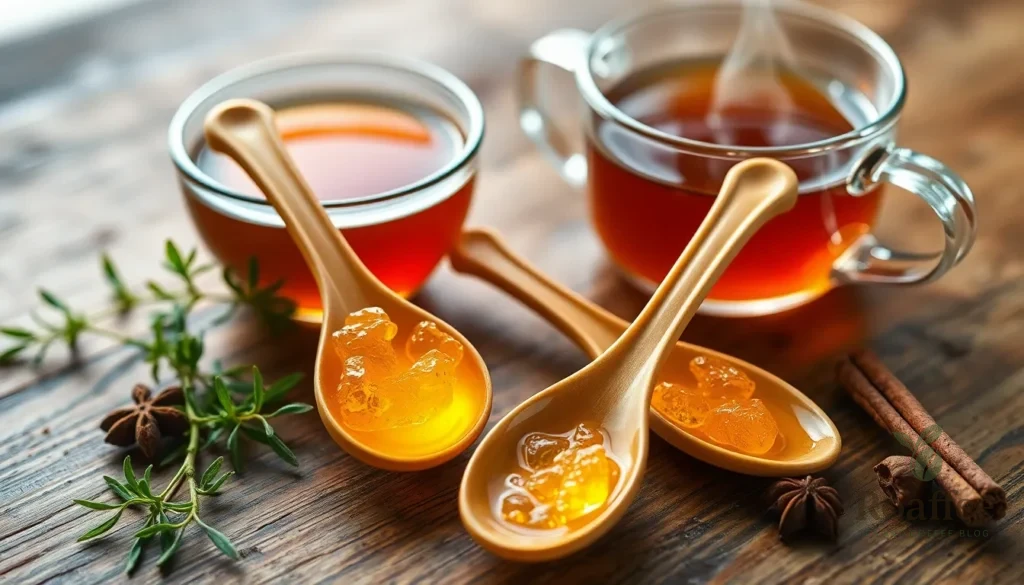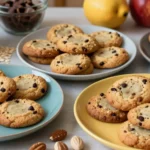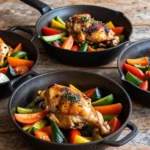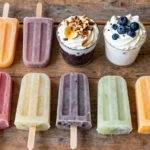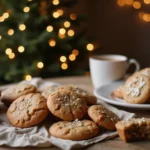We’ve all experienced that moment when we’re stirring honey into our tea and it creates a sticky mess on our spoons. That’s where honey spoons come in – these clever little treats transform your tea time into something truly special while solving the sticky honey problem once and for all.
Honey spoons are edible spoons made from crystallized honey that slowly dissolve in your hot tea, releasing natural sweetness without any waste or mess. They’re not just practical – they’re absolutely delightful conversation starters that’ll impress your guests and elevate your daily tea ritual.
The best part? You can make these elegant honey spoons at home with just a few simple ingredients and minimal effort. We’ll show you exactly how to create these beautiful, functional treats that’ll make every cup of tea feel like a luxurious experience.
What Are Honey Spoons for Tea
Honey spoons for tea are edible utensils crafted from crystallized honey that dissolve completely when stirred into hot beverages. We create these innovative spoons by heating honey to the hard crack stage and molding it into spoon shapes that maintain their form at room temperature yet melt seamlessly in warm tea.
These elegant utensils serve a dual purpose in our tea rituals. First, they eliminate the sticky mess that traditional honey stirring creates by containing the sweetener within the spoon structure itself. Second, they provide precise portion control since each spoon delivers a consistent amount of honey with every use.
The crystallized honey maintains its natural flavor profile while offering a delightful textural experience. We watch as the spoon gradually dissolves, releasing its golden sweetness throughout the tea and creating a mesmerizing swirling effect in the cup. The dissolution process typically takes 30 to 60 seconds depending on the tea temperature and spoon thickness.
Beyond their practical benefits, honey spoons transform ordinary tea time into an interactive experience. Guests often marvel at the novelty of using an edible utensil that disappears during use. The spoons work exceptionally well with various tea types including black teas, green teas, herbal infusions, and even coffee.
We can customize these spoons with additional flavors by incorporating spices like cinnamon, vanilla extract, or dried herbs during the crystallization process. This versatility allows us to create specialized spoons that complement exact tea blends or seasonal preferences.
Benefits of Making Your Own Honey Spoons
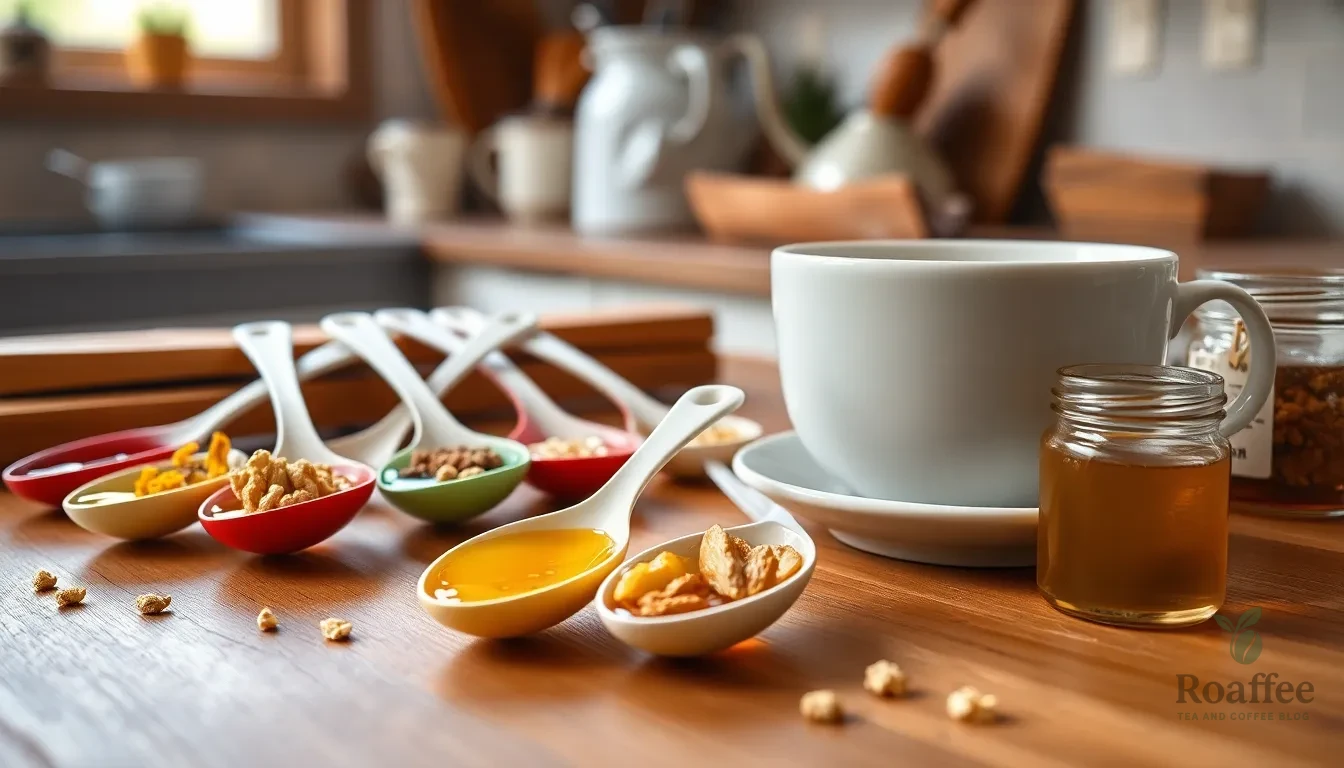
Creating our own honey spoons offers remarkable advantages over purchasing pre-made versions or using traditional honey dispensing methods. We gain complete control over the honey quality by selecting pure honey without added sugars or preservatives that often appear in commercial products.
Customization becomes our greatest asset when crafting these edible utensils at home. We can infuse flavors like lemon zest for immune support or dried herbs such as chamomile for enhanced relaxation benefits. Natural wellness properties flourish when we combine honey’s soothing characteristics with complementary ingredients that support throat health and reduce cough symptoms.
Cost effectiveness proves important when we calculate the savings from making honey spoons ourselves rather than buying specialty versions. A single batch produces multiple spoons for a fraction of the retail price while maintaining superior quality standards. Storage convenience adds another layer of value since properly made honey spoons maintain their shape and effectiveness for weeks when stored in airtight containers.
Gift giving transforms into a thoughtful art form when we present handmade honey spoons with unique handles or decorative molds. Recipients appreciate the personal touch and artisanal quality that commercial products cannot match. Wedding favors and hostess gifts gain special meaning when crafted with care in our own kitchens.
Functional benefits extend beyond simple sweetening as our homemade honey spoons provide precise portion control with each use. We eliminate the guesswork of measuring honey while ensuring consistent flavor in every cup of tea. Temperature control during the heating process allows us to achieve the perfect hard crack stage at 300°F for optimal dissolution timing.
Health conscious tea drinkers benefit from our ability to select raw honey varieties that retain beneficial enzymes and antioxidants often destroyed in commercial processing. We maintain the natural antimicrobial properties that support immune system function during cold and flu seasons.
Ingredients
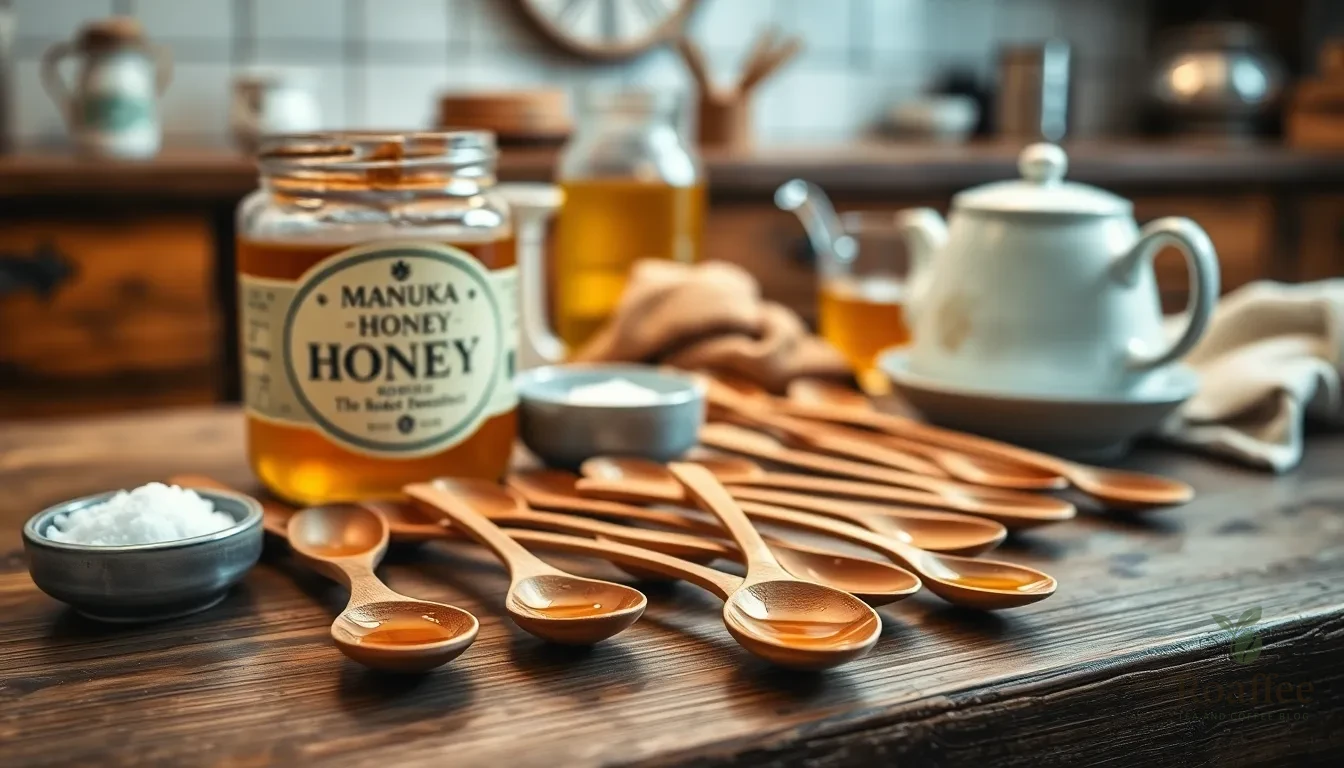
We’ve carefully selected each ingredient to ensure our honey spoons achieve the perfect balance of sweetness and structural integrity. Our recipe focuses on simplicity while delivering exceptional results that will elevate your tea experience.
Essential Ingredients
Honey (3/4 to 1 cup)
- Manuka honey works exceptionally well due to its heat stability and rich flavor profile
- Raw honey varieties retain beneficial enzymes and antioxidants
- Regular honey produces excellent results for those seeking a budget-friendly option
Sugar (4 cups, optional)
- Granulated white sugar helps achieve the hard crack stage more reliably
- Creates a smoother texture and enhanced durability
- Can be omitted for a pure honey approach
Water (1/2 cup)
- Essential when using sugar to create the proper candy consistency
- Helps dissolve sugar evenly during the heating process
- Omit if making honey-only spoons
Texture Enhancers
White Vinegar (2 tablespoons, optional)
- Prevents crystallization during the cooling process
- Creates a smoother final texture
- Helps achieve the perfect hard crack stage
Cream of Tartar (1 tablespoon, optional)
- Stabilizes the candy mixture during heating
- Ensures consistent results every time
- Particularly useful in humid climates
Flavor Customization Options
We recommend selecting one or two complementary flavors to avoid overwhelming the honey’s natural taste:
- Cinnamon – Perfect for black teas and chai blends
- Fresh ginger – Adds warmth and pairs beautifully with green tea
- Lemon zest – Brightens the flavor and complements herbal teas
- Dried rosemary – Creates an elegant botanical note
- Whole cloves – Provides subtle spice for winter tea blends
- Dried lavender – Adds a calming floral essence
Equipment Essentials
Candy Molds or Silicone Molds
- Lollipop molds work perfectly for spoon shapes
- Ensure molds can withstand temperatures up to 300°F
Wooden Sticks
- Heat-resistant wooden sticks prevent melting
- Avoid plastic sticks as they cannot withstand the high temperatures
- Essential for achieving the precise 300°F hard crack stage
- Digital thermometers provide the most accurate readings
Equipment Needed
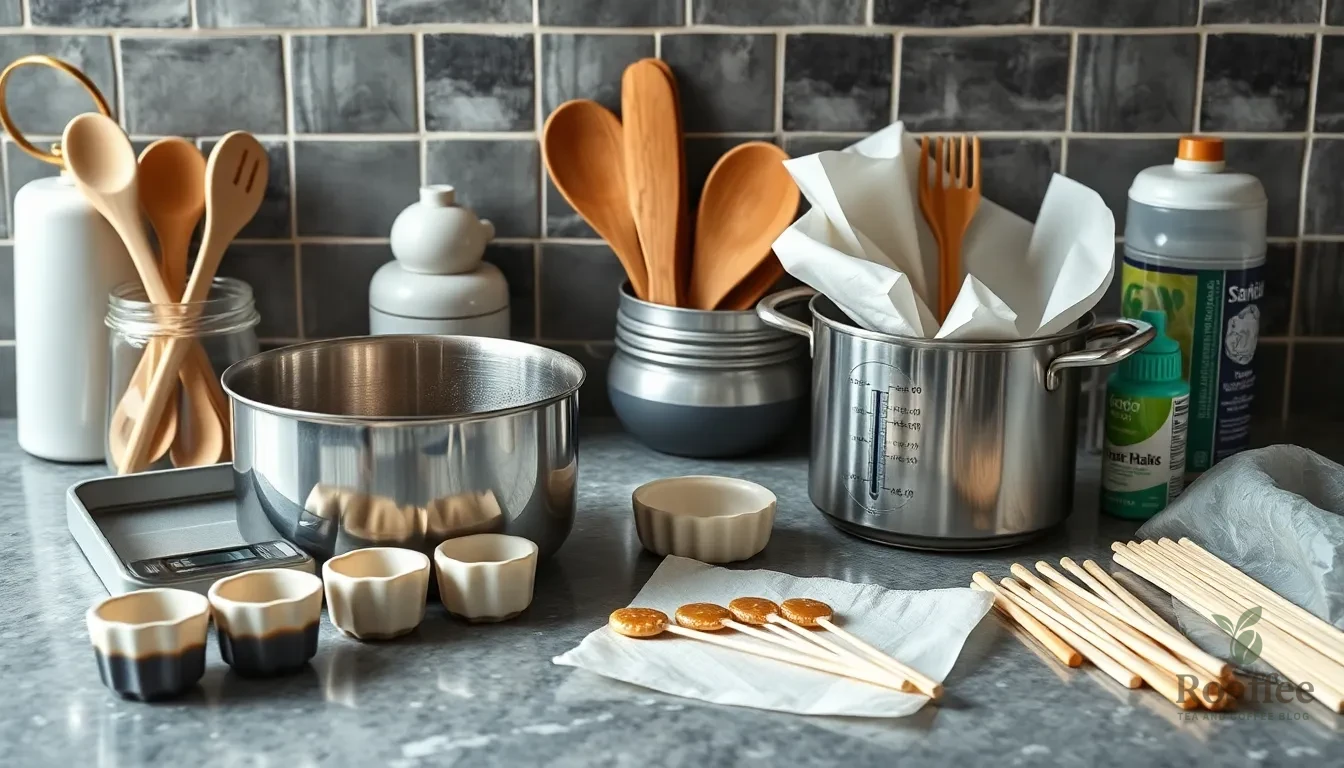
Creating perfect honey spoons requires exact tools to ensure consistent results and safe handling of hot candy temperatures. We recommend gathering all equipment before starting the process to maintain proper timing and temperature control.
Essential Cooking Equipment
Saucepan serves as our primary vessel for heating the honey mixture. We prefer a heavy-bottomed pan that distributes heat evenly and prevents scorching during the cooking process.
Candy thermometer provides precise temperature monitoring essential for achieving the 300°F (148°C) hard crack stage. Digital thermometers offer superior accuracy compared to analog versions and eliminate guesswork in temperature readings.
Wooden spoon becomes our stirring tool of choice due to its heat resistance properties. Wooden utensils withstand high sugar temperatures without melting or conducting heat back to our hands.
Molding and Shaping Tools
Candy molds create uniform honey spoon shapes and ensure consistent sizing across batches. We can substitute with spoon-shaped silicone molds or improvise with actual spoons for coating.
Heat-resistant wooden sticks provide handles for lollipop-style honey spoons when using traditional candy molds. These sticks maintain their integrity under high temperatures unlike plastic alternatives.
Parchment paper lines flat surfaces when creating freeform honey spoons or when molds are unavailable. We recommend using high-quality parchment that won’t curl or burn under heat.
Safety and Preparation Items
| Equipment Type | Purpose | Temperature Tolerance |
|---|---|---|
| Wooden spoons | Stirring and dipping | Up to 400°F |
| Candy thermometer | Temperature monitoring | 300°F+ |
| Parchment paper | Surface lining | 420°F |
| Wooden sticks | Spoon handles | 350°F+ |
Non-stick spray prevents sticking when using molds or parchment paper surfaces. We apply a light coating to ensure easy removal once the honey spoons have hardened.
The equipment selection directly impacts our success rate since plastic tools can melt at the required 300°F (148°C) temperature needed for proper candy formation. Wooden alternatives provide the heat resistance necessary for safe handling throughout the entire cooking process.
Instructions

We’ll walk you through the precise steps to create professional-quality honey spoons that dissolve perfectly in tea. Our method ensures consistent results every time by following temperature guidelines and proper techniques.
Prep the Workspace
We recommend setting up our workspace before heating the honey to ensure smooth execution. Line our work surface with parchment paper for easy cleanup and place our spoon molds or sturdy wooden spoons within easy reach.
If using molds, we should insert the heat-resistant wooden sticks before pouring the honey. Metal or wooden spoons work best as handles since plastic spoons may melt from the high heat required for candy formation.
Melt the Honey
Pour 3/4 to 1 cup of honey into our heavy-bottomed saucepan for even heat distribution. We add 1 tablespoon of cream of tartar to help prevent crystallization during the heating process.
Heat the honey slowly over low to medium heat while stirring constantly with our wooden spoon. We must monitor the temperature using our digital candy thermometer until it reaches 300°F (148°C), which is the hard crack stage crucial for proper hardening.
Avoid quick heating to prevent burning and developing bitter flavors that would compromise the taste of our finished honey spoons.
Add Optional Flavors
We can infuse our honey with various flavors such as lemon peel, fresh ginger, cinnamon sticks, or dried lavender before heating begins. For herbal honey spoons, we recommend infusing the honey with rosemary, cloves, or other spices several days before cooking.
Add our chosen flavorings during the initial heating phase to allow the essences to blend thoroughly with the honey base.
Pour Into Spoon Molds
Once our honey reaches the correct temperature, we stir gently to settle any bubbles before pouring. Work quickly as the honey hardens rapidly once it begins cooling.
Pour the hot honey into our prepared spoon molds or onto the wooden spoons, ensuring the honey covers the top portion of each stick completely. The honey should fill the mold evenly for consistent spoon shapes.
Cool and Set
Allow our honey spoons to cool at room temperature for optimal texture development. We can refrigerate them for 1 to 2 hours to speed the hardening process if needed.
Once completely solid, carefully remove the spoons from their molds or peel them off the parchment paper. Our finished honey spoons will dissolve easily in hot tea while adding natural sweetness and any infused flavors we’ve chosen.
Storage Tips
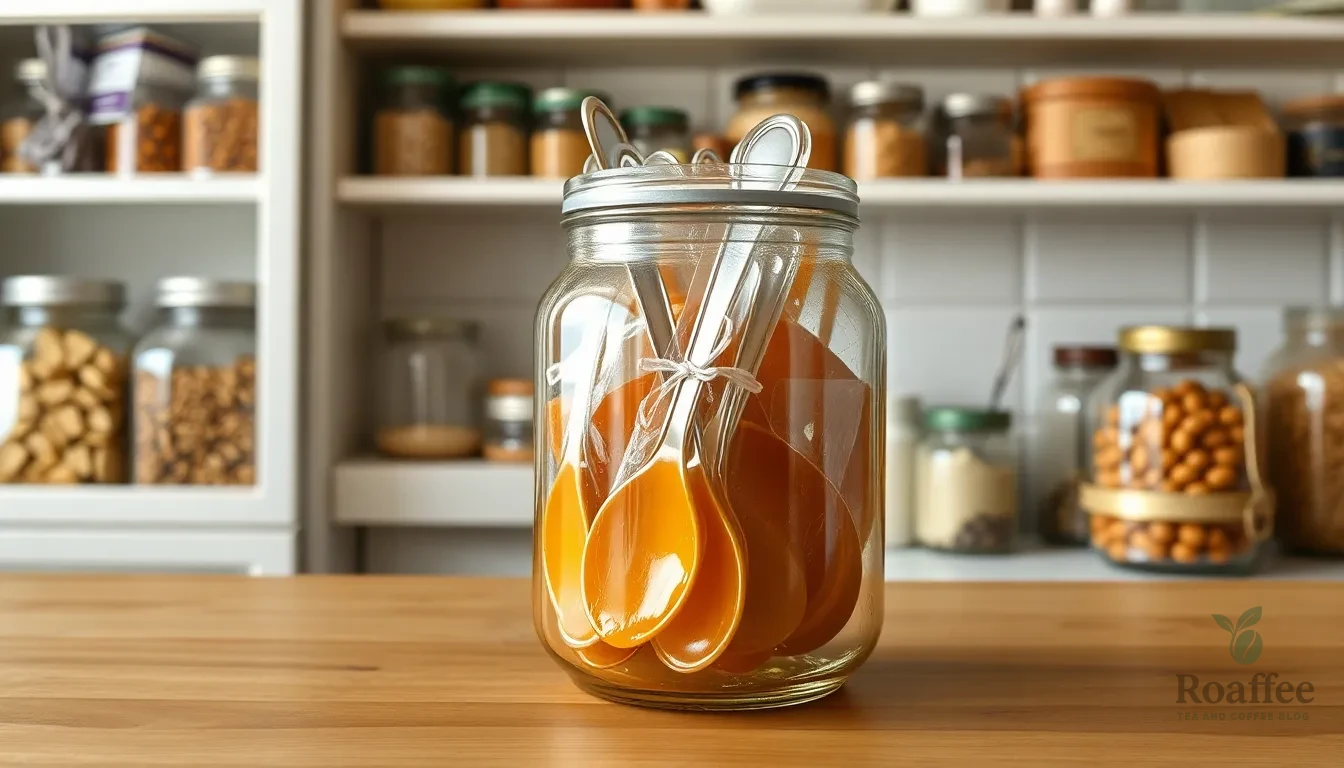
We need to store our honey spoons properly to maintain their crisp texture and prevent moisture absorption. Room temperature storage in an airtight container works best for preserving the hard candy consistency we achieved during the candy-making process.
Direct sunlight and humidity pose the greatest threats to our honey spoons’ quality. These environmental factors cause the crystallized honey to become sticky and lose its solid form. We recommend placing the airtight container in a cool, dry pantry or cupboard away from heat sources like stoves or radiators.
Moisture absorption transforms our perfectly crafted honey spoons into sticky, unusable candy. Adding a food-safe desiccant packet to the storage container provides extra protection against humidity. We can also layer parchment paper between individual spoons to prevent them from sticking together during storage.
| Storage Method | Duration | Temperature Range | Humidity Level |
|---|---|---|---|
| Airtight container | 2-3 months | 60-70°F | Below 50% |
| Refrigerator storage | 4-6 months | 35-40°F | Controlled environment |
| Freezer storage | 6-12 months | 0°F | Minimal moisture |
Temperature fluctuations affect the structural integrity of our honey spoons. Consistent storage conditions prevent the honey from repeatedly softening and hardening, which can create cracks or cause the spoons to break. We avoid storing them near windows where temperature changes occur throughout the day.
Individual wrapping extends storage life significantly. Food-grade cellophane or small plastic bags protect each spoon from air exposure while maintaining visibility. This method works particularly well when we plan to give honey spoons as gifts or need to transport them.
Our honey spoons remain viable for up to three months when stored correctly at room temperature. Refrigerated storage extends this timeframe to six months, though condensation becomes a concern when removing cold spoons and exposing them to warm air. We allow refrigerated spoons to reach room temperature before unwrapping to prevent moisture buildup.
Flavor Variations
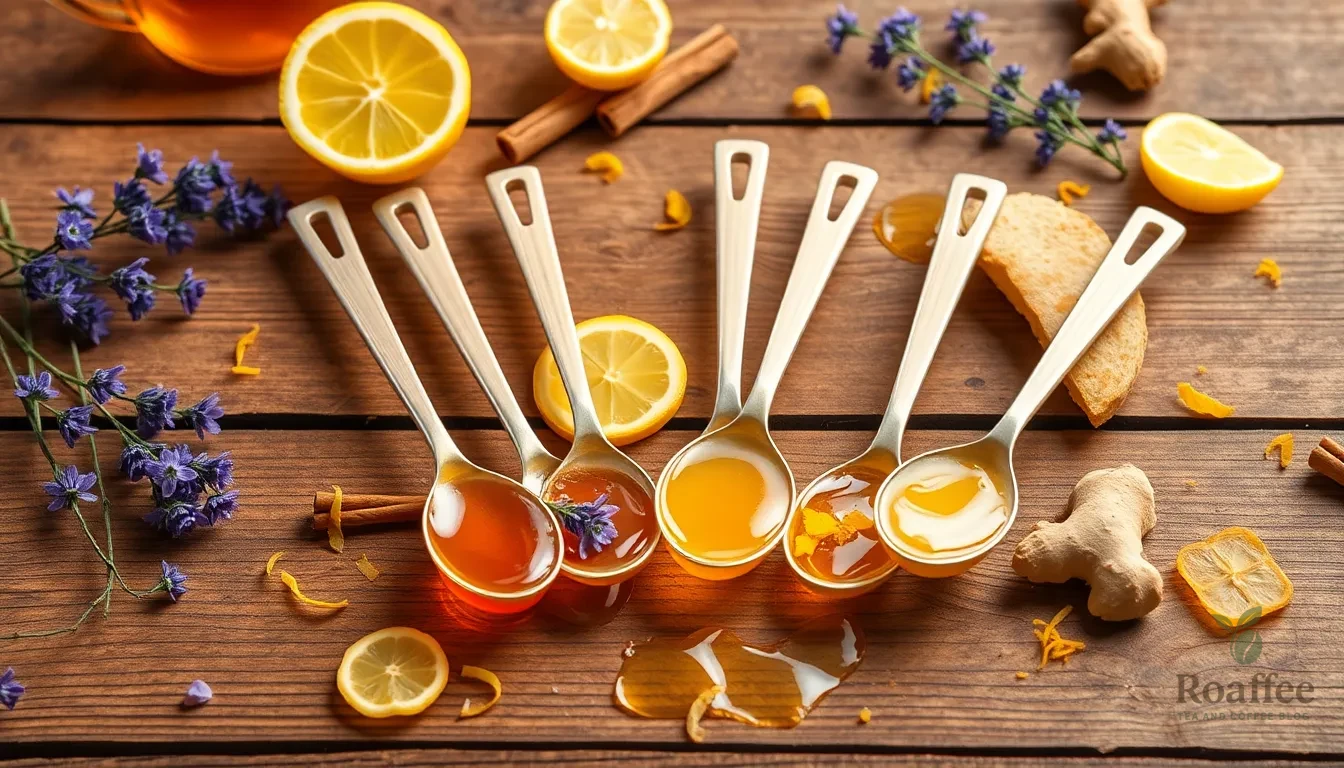
We can transform our basic honey spoons into aromatic delights by infusing them with natural ingredients that complement different tea varieties. These flavor variations add therapeutic benefits while creating a more sophisticated tea experience.
Lavender Honey Spoons
We create these floral honey spoons by adding organic lavender flowers to our honey before heating to 300°F (148°C). The lavender flowers steep in the warming honey for about 5-10 minutes before we strain them out completely. We then pour the infused honey into our prepared molds and garnish each spoon with a few lavender buds for visual appeal. These spoons provide a calming floral note that pairs beautifully with chamomile or Earl Grey teas. The natural properties of lavender can help soothe sore throats and promote relaxation during evening tea rituals.
Cinnamon Honey Spoons
We infuse our honey with warm cinnamon by adding whole cinnamon sticks to the honey during the heating process. The cinnamon sticks steep in the honey over low heat for up to 10 minutes, allowing the spice to release its aromatic oils. We remove the cinnamon sticks before the honey reaches the hard crack stage at 300°F (148°C). These spoons deliver a warm, spiced flavor that perfectly complements black teas, chai blends, or coffee during fall and winter months. The cinnamon adds natural antimicrobial properties while creating a cozy, festive atmosphere.
Lemon Honey Spoons
We brighten our honey spoons with fresh lemon zest or peel added during the warming process. The citrus oils release into the honey as it heats, creating a vibrant flavor profile that we strain out before molding. These lemon-infused spoons add a refreshing brightness that enhances both black and green teas. The citrus notes provide vitamin C benefits while creating a perfect balance of sweet and tart flavors. We find these spoons particularly enjoyable with morning teas or when fighting off seasonal sniffles.
Ginger Honey Spoons
We incorporate fresh or dried ginger pieces into our honey during the warming phase to create these warming spoons. The ginger pieces steep in the honey for 8-10 minutes, releasing their spicy essence before we strain them out completely. These spoons provide a gentle heat that pairs exceptionally well with herbal teas or green tea blends. The ginger adds digestive benefits and natural anti-inflammatory properties to our tea experience. We recommend these spoons for anyone seeking a warming, slightly spicy addition to their daily tea ritual.
How to Use Your Honey Spoons
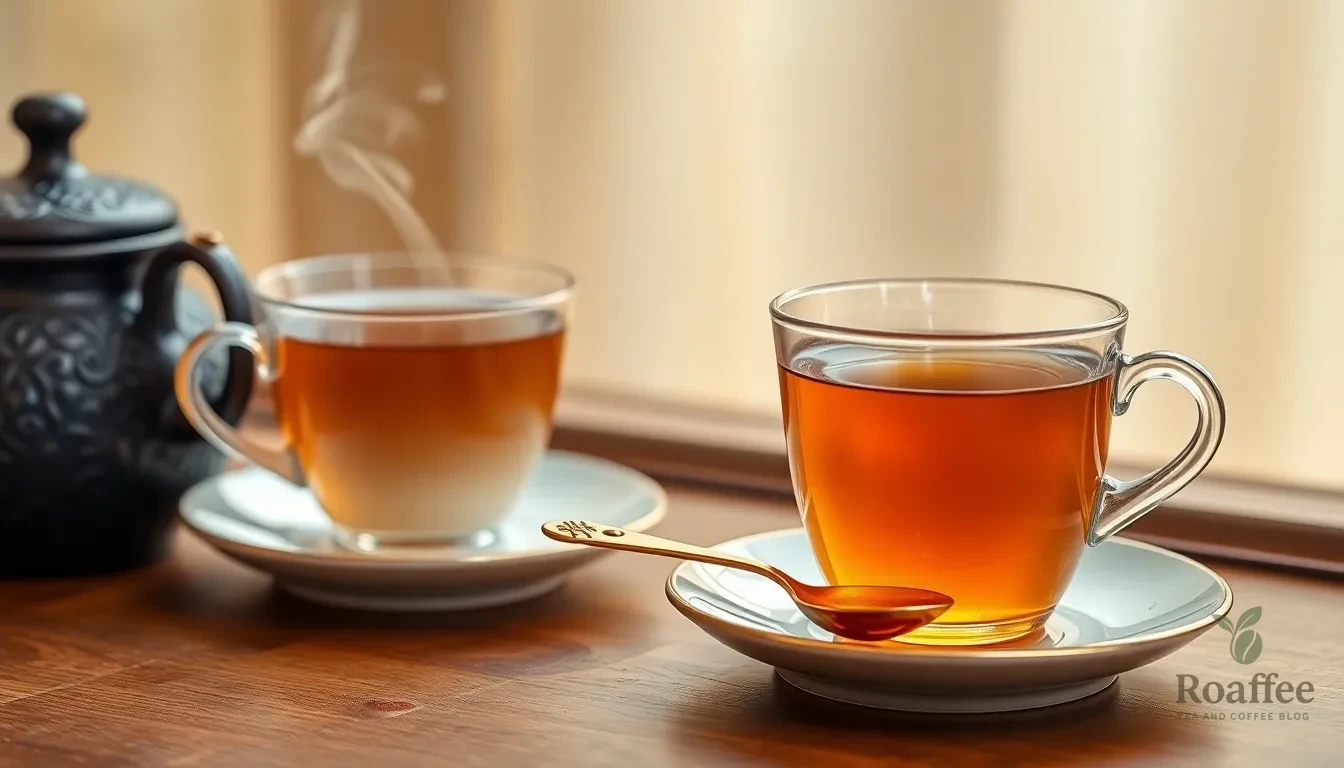
Now that we’ve created these delightful honey spoons, let’s explore how to use them properly to enhance our tea experience. The beauty of honey spoons lies in their simplicity and the magical transformation they create when stirred into hot beverages.
Optimal Tea Temperature
We recommend using water heated to 185-205°F for the best dissolution experience. This temperature range ensures our honey spoons dissolve smoothly without creating sticky residue at the bottom of the cup. Different tea types require exact temperatures, and our honey spoons work beautifully across this entire spectrum.
| Tea Type | Water Temperature | Dissolution Time |
|---|---|---|
| Green Tea | 185°F | 30-45 seconds |
| Black Tea | 205°F | 20-30 seconds |
| Herbal Tea | 200°F | 25-40 seconds |
| Oolong Tea | 195°F | 35-50 seconds |
Proper Stirring Technique
We simply place our honey spoon into the hot tea and stir gently in circular motions. The hardened honey begins dissolving immediately, creating beautiful swirling patterns in the cup. Avoid vigorous stirring as this can cause splashing and doesn’t improve the dissolution rate.
Dissolution Process
Our honey spoons typically dissolve completely within 30 to 60 seconds, depending on the tea temperature and spoon thickness. The process creates a mesmerizing visual effect as the honey slowly releases its sweetness throughout the beverage. We can observe the golden streams of honey creating natural patterns in our tea.
Beverage Compatibility
These versatile spoons work exceptionally well with various hot beverages beyond traditional tea. We can use them in coffee, hot chocolate, or even warm milk for a naturally sweet treat. The honey flavor complements most beverages without overpowering their original taste profiles.
Portion Control Benefits
Each honey spoon delivers a consistent amount of sweetness, eliminating the guesswork involved in measuring liquid honey. We’ve found that one standard honey spoon provides approximately one teaspoon of honey, perfect for a single cup of tea. This precision makes our tea preparation more consistent and enjoyable.
Serving Suggestions
We recommend presenting honey spoons alongside our tea service for an elevated experience. Guests can stir their own spoons, creating an interactive element that sparks conversation. The spoons maintain their shape at room temperature, making them perfect for formal tea parties or casual gatherings.
Storage During Use
Keep unused honey spoons in a dry location away from steam and moisture during tea service. We avoid placing them near the kettle or in humid environments, as this can cause premature softening. Room temperature storage ensures they maintain their crisp texture until ready for use.
Troubleshooting Common Issues
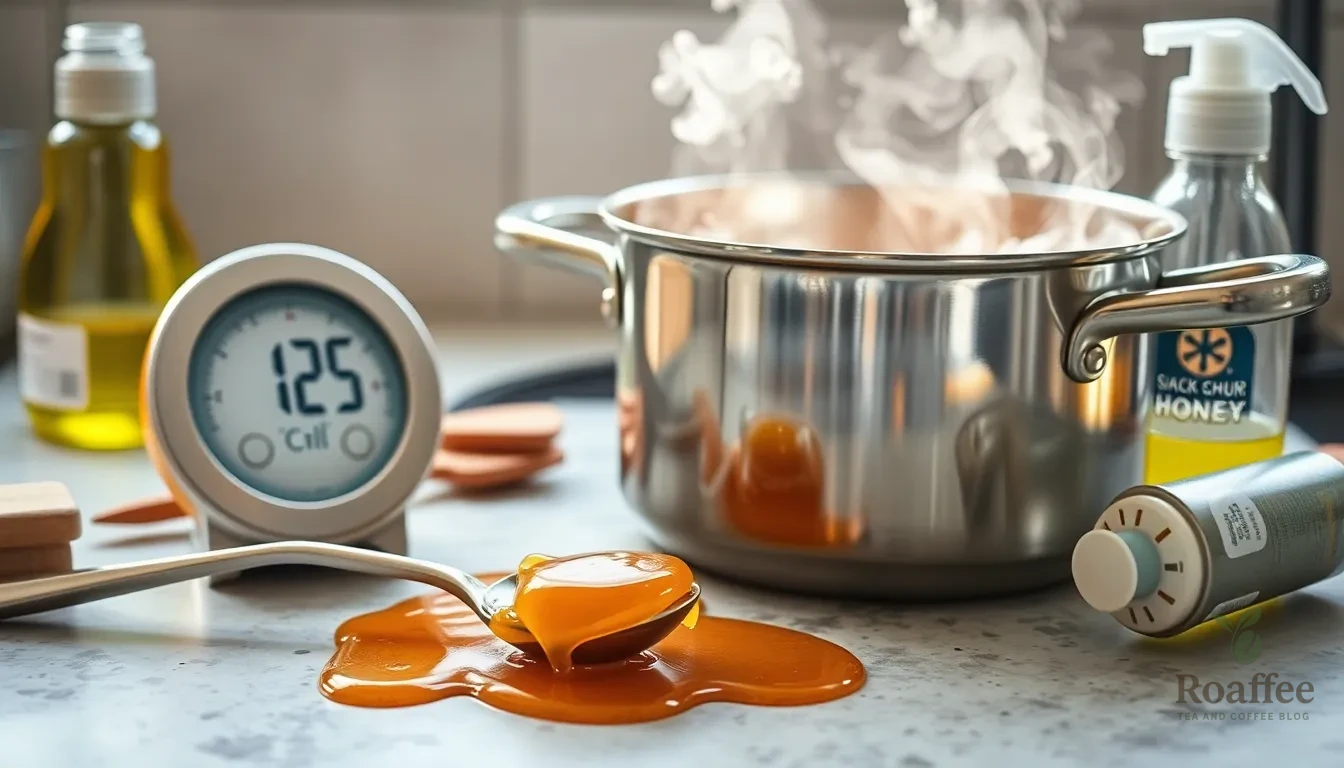
Working with hot honey can present unique challenges that require exact answers. We’ve identified the most common problems home cooks encounter and developed practical fixes to ensure your honey spoons turn out perfectly every time.
Temperature Control Problems
Temperature accuracy remains the most critical factor in creating successful honey spoons. When your honey mixture fails to reach the hard crack stage at 300°F, the spoons won’t harden properly or will dissolve too slowly in your tea. We recommend investing in a digital candy thermometer for precise temperature monitoring throughout the heating process.
| Temperature Stage | Result | Solution |
|---|---|---|
| Below 300°F | Soft, sticky spoons | Continue heating until thermometer reads 300°F |
| Above 320°F | Burnt, bitter honey | Start over with fresh honey |
| Fluctuating temps | Inconsistent texture | Use heavy-bottomed saucepan for even heating |
Sticky Mess Management
Hot honey creates an incredibly sticky mess that can frustrate even experienced candy makers. We suggest preparing your workspace with paper towels and having a sticky surface cleaner readily available before you begin heating the honey. Position these cleaning supplies within arm’s reach of your cooking area to address spills immediately.
Coating your measuring spoons and stirring utensils with a light spray of cooking oil prevents honey from adhering to the surfaces. This simple preparation step saves important cleanup time and reduces waste.
Stirring Technique Issues
Many home cooks make the mistake of continuing to stir the honey mixture after it reaches boiling point. Once your honey mixture is well combined and begins boiling, avoid stirring it again to prevent crystallization or unwanted texture changes. The constant agitation can introduce air bubbles and create a grainy finish in your final product.
Molding and Removal Challenges
Honey spoons that stick to molds or break during removal indicate inadequate mold preparation. We recommend lightly coating your molds with non-stick spray or a thin layer of neutral oil before pouring the hot honey mixture. Allow the spoons to cool completely at room temperature before attempting removal.
If spoons crack during removal, the honey likely cooled too quickly. Moving the molds to a warmer area of your kitchen can slow the cooling process and reduce thermal shock that causes cracking.
Humidity and Weather Complications
High humidity days can prevent honey spoons from setting properly or cause them to become sticky after cooling. We suggest avoiding honey spoon making on particularly humid days when possible. If you must proceed, run a dehumidifier in your kitchen or choose an air-conditioned room for the cooling process.
Weather conditions affect honey’s behavior significantly. Cold temperatures can make the honey mixture too thick to pour smoothly, while hot weather can prevent proper hardening even after extended cooling times.
Make-Ahead Instructions
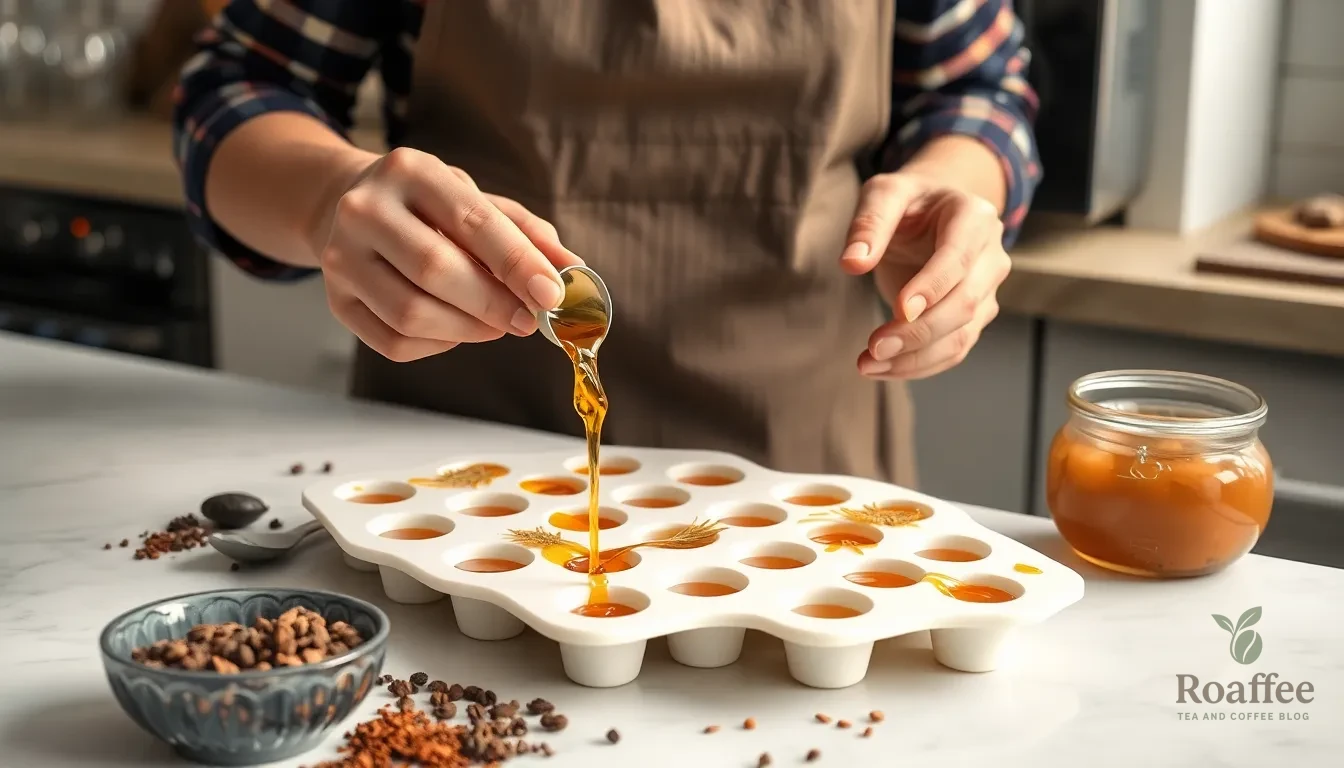
Planning ahead transforms honey spoon preparation from a last-minute activity into a relaxed process that yields superior results. We recommend starting your honey spoon project 2-3 days before you plan to serve them to allow time for proper cooling and flavor development.
Timing Your Preparation
Begin the preparation process by infusing your honey with desired flavors 24-48 hours before making the spoons. This extended steeping time creates deeper flavor profiles that enhance the overall tea experience. Store the infused honey in a sealed container at room temperature during this period.
Schedule your actual honey spoon making session for the day before you need them. The cooling and hardening process requires at least 1-2 hours at room temperature or 30-45 minutes in the refrigerator. We find that overnight cooling produces the most consistent texture and clarity.
Batch Preparation Strategy
Create multiple batches using different molds to maximize your time efficiency. Start with your first batch and while it cools move on to preparing the second batch. This approach allows you to produce 50-100 honey spoons in a single afternoon session.
Prepare your workspace completely before beginning any heating process. Set up all molds arrange your sticks and have your thermometer ready. This preparation prevents rushed moments when working with 300°F honey.
Storage After Making
Allow freshly made honey spoons to cool completely to room temperature before removing from molds. This cooling period typically takes 2-3 hours depending on your kitchen temperature and humidity levels.
Remove the spoons from molds gently and immediately transfer them to airtight containers. Layer parchment paper between each level of spoons to prevent sticking. We recommend using glass containers with tight-fitting lids for optimal freshness.
| Storage Method | Duration | Temperature | Humidity Level |
|---|---|---|---|
| Room Temperature | 2-3 months | 65-70°F | Below 50% |
| Refrigerator | 4-6 months | 35-40°F | Sealed container |
| Freezer | 6-12 months | 0°F | Airtight wrapping |
Pre-Event Preparation
Prepare honey spoons up to one week before special events or tea parties. This timeline allows for any adjustments or additional batches if needed. Store them in individual cellophane bags for an elegant presentation that also protects against moisture.
Create a preparation checklist that includes ingredient gathering equipment setup and timing schedules. This organization ensures smooth execution when you begin the actual candy making process.
Test your recipe with a small batch first especially when trying new flavor combinations. This trial run helps identify any adjustments needed before preparing larger quantities for your event.
Gift Ideas and Packaging
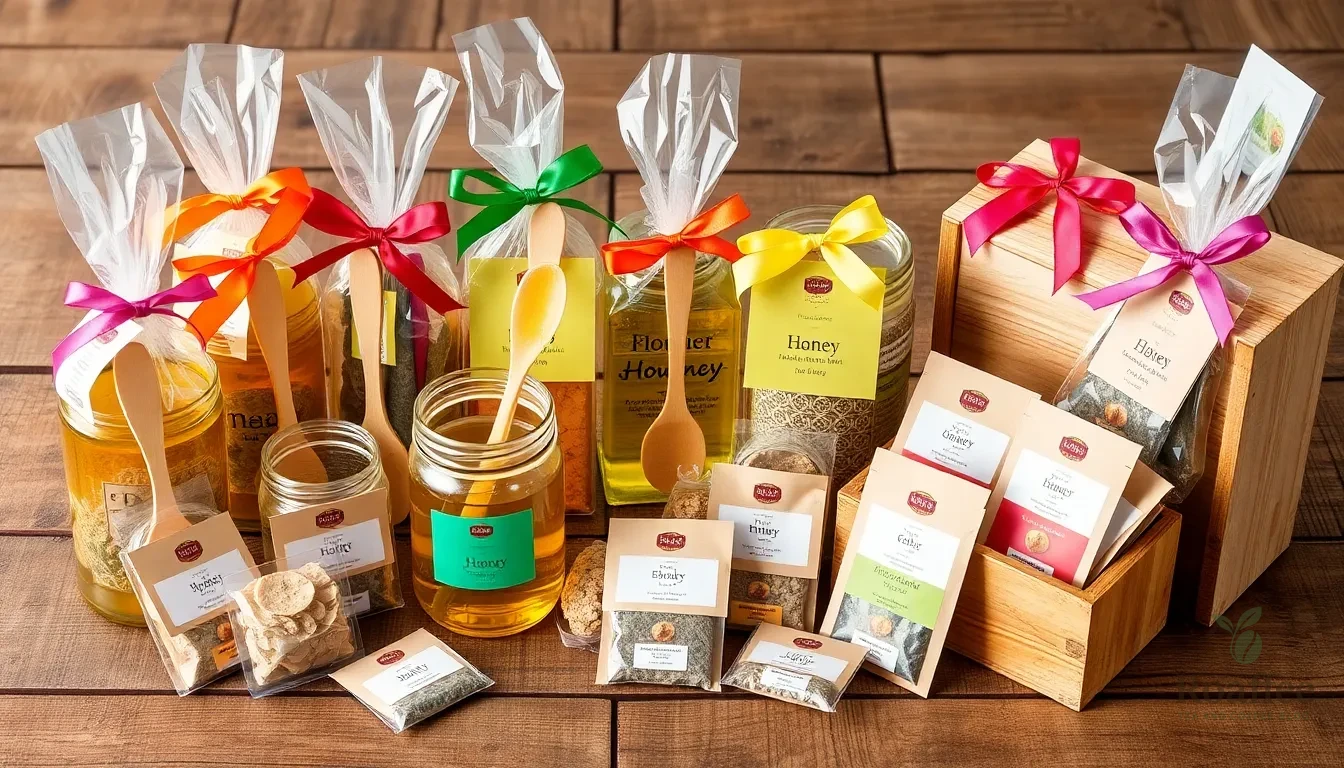
Honey spoons make exceptional gifts that combine functionality with thoughtful presentation. We can transform these elegant treats into memorable presents that tea lovers will treasure long after the sweetness dissolves.
Presentation Options
Beautiful packaging elevates honey spoons from homemade treats to sophisticated gifts. Clear cellophane bags tied with ribbons create an elegant display while protecting the delicate candy structure. Small mason jars work perfectly for gift sets, allowing recipients to see the beautiful honey spoons while keeping them fresh. Wooden boxes lined with parchment paper provide a rustic charm that complements the natural honey aesthetic.
Individual wrapping adds a professional touch to each honey spoon. Tissue paper in soft colors creates delicate parcels that feel special when unwrapped. Clear acetate boxes showcase the honey spoons beautifully and stack easily for gift giving. We recommend including small cards that explain how to use the spoons, making them accessible to recipients who may be unfamiliar with this unique tea accessory.
Gift Set Ideas
Creating themed gift sets amplifies the appeal of honey spoons as presents. A tea lover’s collection might include different flavor varieties like lavender, cinnamon, and ginger honey spoons paired with premium tea bags. Holiday themed sets work wonderfully with seasonal flavors and festive packaging that matches the occasion.
Wedding favors benefit from honey spoons’ romantic appeal and practical nature. Small kraft paper bags stamped with the couple’s initials create meaningful keepsakes that guests can actually use. Baby shower gifts gain extra sweetness when honey spoons are paired with caffeine-free herbal teas and presented in soft pastel packaging.
Labeling and Instructions
Clear labeling ensures recipients understand and appreciate their unique gift. We suggest including the honey type, flavor infusions, and creation date on each package. Simple instruction cards explaining the dissolution process help newcomers enjoy the full honey spoon experience.
Storage instructions become crucial for gift recipients who may not use the spoons immediately. Including information about proper storage conditions helps maintain the honey spoons’ crisp texture and prevents disappointment. We recommend adding expiration dates to ensure optimal quality and safety.
Bulk Preparation for Gifting
Planning ahead makes honey spoon gifting manageable and stress-free. Creating multiple batches allows for variety in gift sets while maximizing our time efficiency. We can prepare different flavor profiles weeks in advance and store them properly until packaging time arrives.
Batch consistency becomes important when making honey spoons for multiple recipients. Using the same molds and techniques ensures uniform appearance across all gifts. Temperature control remains critical during bulk preparation, as multiple batches require consistent heating and cooling procedures to maintain quality standards.
Conclusion
Making honey spoons transforms your tea ritual into something truly special. We’ve covered everything from selecting the perfect honey to mastering temperature control and creating stunning flavor combinations that’ll impress any tea lover.
These delightful creations offer more than just sweetness – they’re conversation starters that dissolve beautifully into your favorite brew. Whether you’re crafting them for personal enjoyment or as thoughtful gifts, the process is both rewarding and surprisingly simple.
The beauty of homemade honey spoons lies in their versatility. You can customize flavors to match your mood, prepare them well in advance, and store them for months without losing their charm.
So grab your thermometer and molds, and start creating these edible masterpieces. Your tea time will never be the same, and neither will your guests’ reactions when they witness the magic of a honey spoon dissolving into their cup.
Frequently Asked Questions
What are honey spoons and how do they work?
Honey spoons are edible utensils made from crystallized honey that dissolve in hot tea or coffee. They’re crafted by heating honey to the hard crack stage (300°F) and molding it into spoon shapes. When placed in warm beverages, they dissolve within 30-60 seconds, adding sweetness while eliminating the mess of traditional honey stirring.
How long do homemade honey spoons last?
Homemade honey spoons can last 2-3 months at room temperature when stored in an airtight container. For extended storage, refrigerate them for 4-6 months or freeze for 6-12 months. Keep them away from humidity and direct sunlight to maintain their crisp texture and prevent sticking.
Can I customize honey spoons with different flavors?
Yes, honey spoons are highly customizable. You can infuse them with various flavors like cinnamon, lemon zest, fresh ginger, dried lavender, or rosemary. Add these ingredients during the heating process to create unique flavor combinations that complement different tea types and personal preferences.
What equipment do I need to make honey spoons at home?
Essential equipment includes a heavy-bottomed saucepan, digital candy thermometer, heat-resistant wooden spoons, candy molds, and parchment paper. You’ll also need non-stick spray and optionally heat-resistant wooden sticks for handles. Avoid plastic tools as they may melt at the high temperatures required.
What’s the best way to store honey spoons?
Store honey spoons in an airtight container at room temperature, away from humidity and direct sunlight. For individual storage, wrap each spoon in parchment paper. If refrigerated, allow them to reach room temperature before unwrapping to prevent condensation from making them sticky.
Are honey spoons suitable as gifts?
Absolutely! Honey spoons make exceptional gifts for tea lovers. Present them in clear cellophane bags, mason jars, or wooden boxes with usage instructions. They’re perfect for wedding favors, hostess gifts, or themed tea sets. Individual wrapping enhances their appeal and maintains freshness.
What temperature should my tea be for honey spoons to dissolve properly?
For optimal dissolution, use water temperatures between 160-212°F depending on your tea type. Black teas work best at boiling temperature, while green teas should be around 160-180°F. The honey spoon will dissolve smoothly in these temperature ranges, creating beautiful swirling patterns.
How do I prevent honey spoons from becoming sticky?
Ensure honey reaches the hard crack stage (300°F) during cooking and store in low-humidity conditions. Use airtight containers with desiccant packets if needed. Avoid exposing them to moisture, steam, or humid environments. Proper temperature control during making is crucial for preventing stickiness.

